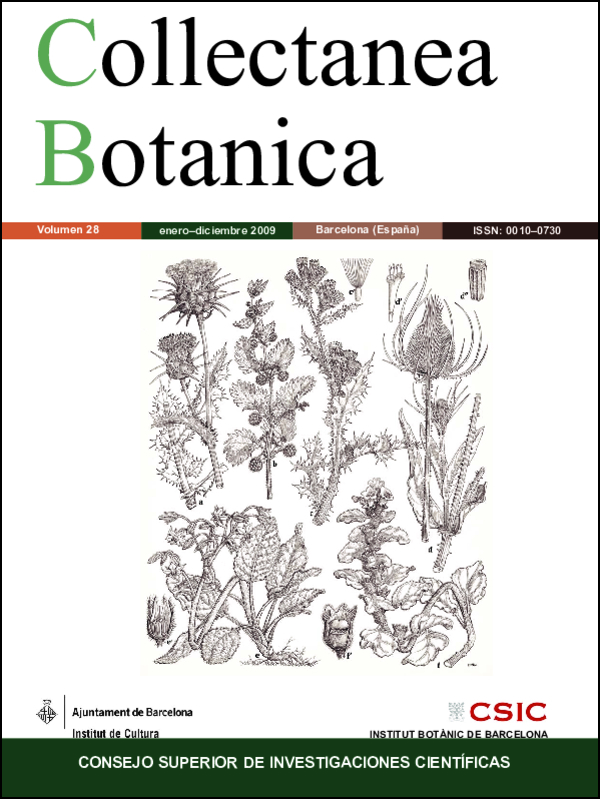Ursinia nana (Anthemideae, Asteraceae), an adventive from South Africa which is becoming naturalized in the NE Iberian Peninsula. Observations about its reproductive biology and fruit dispersal mechanisms
DOI:
https://doi.org/10.3989/collectbot.2008.v28.010Keywords:
annuals, autogamy, Catalonia, floral structure, fruit predation, geitonogamy, Messor barbarus, naturalization process, pollination ecology, Spain, UrsiniaAbstract
The presence of Ursinia nana, an Anthemideae of South-African origin which has been introduced into the NE Iberian Peninsula, is reported for the first time in Europe. The data offered cover its precise location, morphology, chromosome number, ecology and a population census, as well as its life cycle, floral structure, reproductive biology and fruit dispersal mechanisms. Of special note are the clear predominance of autogamy (geitonogamy) over xenogamy as a reproductive system and the large number of fruits produced with high and immediate germinative capacity. These characteristics permit rapid colonization by the introduced species, which can become invasive. However, fruit predation by the ant Messor barbarus points to a natural mechanism that helps regulate population growth and makes biological control possible. Finally its possibilities of expansion in the colonized area and of naturalization in the NE Iberian Peninsula are assessed.
Downloads
References
Bond, P. & Goldblatt, P. 1984. Plants of the Cape flora: a descriptive catalogue. J. S. African Bot., Suppl. 13.
Burke, A. 1997. The impact of large herbivores on floral composition and vegetation structure in the Naukluft Mountains, Namibia. Biodiversity and Conservation 6(9): 1203-1217. doi:10.1023/A:1018308907241
Clothier, T. 2003. Annual/Biennial Germination Database. Retrieved 20 Aug, 2009, from http://tomclothier.hort.net/index.html
Cullen, J. 2000. Ursinia Gaertn. In: Cullen et al. (Eds.), The European Garden Flora 6(4). Cambridge University Press, Cambridge: 598.
Dean, W. R. J. & Yeaton, R. I. 1993. The infl uence of harvester and Messor capensis nest-mounds on the productivity and distribution of some plant species in the southern Karoo, South Africa. Pl. Ecol. 106(1): 21-35. doi:10.1007/BF00044856
Everett, T. H. 1982. The New York Botanical Garden illustrated encyclopedia of horticulture 10. Garland Publishing, New York.
Faegri, K. & Van der Pijl, L. 1980. The Principles of Pollination Ecology (3rd Ed.). Pergamon Press, Oxford.
GCW. 2007. Global Compendium of Weeds Website – Hawaiian Ecosystems at Risk (HEAR). Retrieved 20 Aug, 2009, from http://www.hear.org/gcw/index.html
Goldblatt, P., Berhardt, P. & Manning, J. C. 1998. Pollination of Petaloid Geophytes by Monkey Beetles (Scarabaeidae: Rutelinae: Hoplini) in Southern Africa. Ann. Missouri Bot. Gard. 85(2): 215-230. doi:10.2307/2992006
Haessler, I. 1967. Chomosomenzahlen aus der gattung Ursinia. Mitt. Bot. München 6: 531-539.
Hilliard, O. M. 1977. Compositae in Natal. University of Natal Press, Pietermaritzburg.
Liu, Y., Zhang, S. & Abreu, P. J. M. 2006. Heterocyclic terpenes: linear furano and pyrroloterpenoids. Nat. Prod. Rep. 23: 630-651. doi:10.1039/b604586c PMid:16874393
Molero, J. & Rovira, A. 2002. Kariological evolution and molecular phylogeny in Macaronesia dendroid spurges (Euphorbia subsect. Pachycladae). Plant Syst. Evol. 231: 109-132. doi:10.1007/s006060200014
Prassler, M. 1967. Revision der gattung Ursinia. Mitt. Bot. München 6: 363-478.
Retief, E. & Herman, P. P. J. 1997. Plants of the northern provinces of South Africa: keys and diagnostic characters. Strelitzia 6: 342-343.
Scott, J. K. & Panetta, F. D. 1993. Predicting the Australian weed status of southern African plants. J. Biogeogr. 20: 87-93. doi:10.2307/2845742
Schütz, W., Milberg, P. & Lamont, B. B. 2002. Seed Dormancy, After-ripening and Light Requirements of Four Annual Asteraceae in South-western Australia. Ann. Bot. (Oxford) 90: 707-714. doi:10.1093/aob/mcf250 PMid:12451026
Symonides, E. 1988. On the ecology and evolution of annual plants in disturbed environments. Vegetatio 77: 21-31. doi:10.1007/BF00045746
Ueckermann, C. & van Rooyen, M. W. 2000. Insect pollination and seed set in four ephemeral plant species from Namaqualand. S. African J. Bot. 66(1): 28-30.
Van der Walt, L. 2001. Ursinia cakilefolia DC. South African National Biodiversity Institute. Retrieved 6 Jun, 2007, from: http://www.plantzafrica.com/planttuv/ursiniacakil.htm
Van Wyk, B. & Malan, S. 1988. Field guide to the wild fl owers of the Witwatersrand and Pretoria region, including the Magaliesberg and Suikerbosrand. Struik, Cape Town.
Downloads
Published
How to Cite
Issue
Section
License
Copyright (c) 2009 Consejo Superior de Investigaciones Científicas (CSIC)

This work is licensed under a Creative Commons Attribution 4.0 International License.
© CSIC. Manuscripts published in both the print and online versions of this journal are the property of the Consejo Superior de Investigaciones Científicas, and quoting this source is a requirement for any partial or full reproduction.
All contents of this electronic edition, except where otherwise noted, are distributed under a Creative Commons Attribution 4.0 International (CC BY 4.0) licence. You may read the basic information and the legal text of the licence. The indication of the CC BY 4.0 licence must be expressly stated in this way when necessary.
Self-archiving in repositories, personal webpages or similar, of any version other than the final version of the work produced by the publisher, is not allowed.














